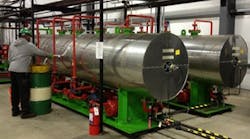Gus Kellogg is founder, president and CEO of Greenleaf Biofuels.
Rahul Bobbili is vice president of technology at JatroDiesel.
Dianna Overmyer is lead automation engineer at Cornerstone Controls.
Biodiesel can be produced from a large number of organic terrestrial and aquatic materials including vegetable and algal oils, as well as commercial and industrial wastes, such as waste vegetable oil, animal fat, and/or recycled cooking grease.
After considerable investigation, Greenleaf Biofuels chose to construct its cost-effective, moderate-sized biofuel production plant within the fuel storage tank farm of New Haven Harbor, thereby providing easy access to truck, rail, barge and deep-water vessel delivery points. And even though Greenleaf intends to use trucked-in waste vegetable oils collected from restaurants and food manufacturers along the Boston to New York City corridor, the New Haven Harbor location provides Greenleaf the option to use a wide array of feedstock delivery methods.
The New Haven Harbor also strategically places Greenleaf's biodiesel product at a key home heating oil distribution hub that annually delivers about 400 million gallons of home heating oil to local businesses and residents.
(Alternative Fuels Industry Requires Capital Investments in Control)
The Biodiesel Process
A growing number of batch- and continuous-feed technology alternatives are available for producing biodiesel. Acid esterification and base transesterification are among the more popular, mainly because they can handle a wide variety of feedstocks ranging from used oils and animal fats to virgin oils. Greenleaf Biofuels evaluated various methods and chose a fully continuous-feed biodiesel production technology developed by JatroDiesel.
JatroDiesel's process begins by drying the feedstock. Next, acid esterification takes place, using methanol and sulfuric acid to convert free fatty acids into methyl ester. The methyl ester is passed through a dual-stage transesterification process, which converts triglycerides into biodiesel and glycerin. The glycerin and excess methanol are removed from the biodiesel, purified and cycled back for reuse in the process.
The biodiesel is polished using magnesium silicate-based compounds to eliminate any trace amounts of glycerin (soap) and then passes through a final filter on its way to finished product storage.
(Sounds corny, but biomass may save America)
Compliance Is Just the First Step
Locating the process in the New Haven harbor area allows Greenleaf Biofuels to strategically leverage myriad distribution and transportation options, but it also imparts significant responsibilities. Following local, state and federal regulations, Greenleaf has implemented:
- A high-capacity, water-deluge building sprinkler system designed to protect the entire processing area.
- A building ventilation system designed to draw fresh-air across the entire processing area.
- A foam fire suppression system designed to protect the methanol truck unloading and tank-farm area.
- A hardwired safety-instrumented-system.
Additional process protection measures include ongoing operator training and a robust process control system designed to assist operators in maintaining the safe and efficient production of biodiesel.
To ensure Greenleaf operators have accurate, timely process information presented in easy to interpret, easy to use graphical displays, Emerson Process Management DeltaV operator stations were implemented using human-centered design (HCD) practices, and standardized dynamos embedded in the DeltaV digital automation system. Rooted in military and international standards, HCD graphic displays use:
- Contrasting colors to bring immediate focus on critical operational information including alarms, status, trends, process and efficiency information.
- Standardized dashboards that allow operators to interact with a variety of field devices in a consistent manner.
- Instant operator access to detailed textual alarm help (i.e., probable causes, recommended actions, and likely consequences).
The HCD graphics and embedded dynamos are designed to provide each shift of operators with accurate, timely and easy to interpret process information so that the process operates at maximum efficiency and none of the protection systems become active.
Every Day a Best Day
Every continuous process consists of measured variables, some of which are directly controlled, others provide indication of overall process performance. Each of these variables, and especially the controlled variables, have an ideal range - the range that when maintained, maximizes overall production efficiency. This sort of efficiency is sometimes referred to as the "golden run," the result of the best operator on their best day, and is the ultimate goal of every production and plant manager around the world.
(The global energy future – Part 3)
Greenleaf Biofuels and JatroDiesel fully recognized that installing a robust process automation system, one that could provide operators with timely and relevant information, would help achieve the goal of having golden runs in the New Haven plant every day. By combining well-trained operators with a well-designed process automation system that includes optimized control algorithms and provides operators with past, present and anticipated future process knowledge, Greenleaf Biofuels is well on its way to maximizing its production efficiencies.
On Track to 10 Million
Slightly more than a year after breaking ground, permitting, construction, inspections, initial employee hiring and training are complete and the facility is on target toward producing 10 million gallons of biodiesel per year.
During a tour of the plant, State Senate Majority Leader Martin Looney said, "We are thrilled that this facility is located here because we see it in many ways as the cutting edge wave of future energy projects. Biodiesel is an exciting opportunity and we hope it will grow and expand. It is a clean and safe energy source that will help us move toward energy independence."
When Rudolph Diesel invented the diesel engine in the 1890s, he envisioned it being powered by peanut oil. Greenleaf Biofuels is proud to be contributing to the fulfillment of Diesel's vision.




